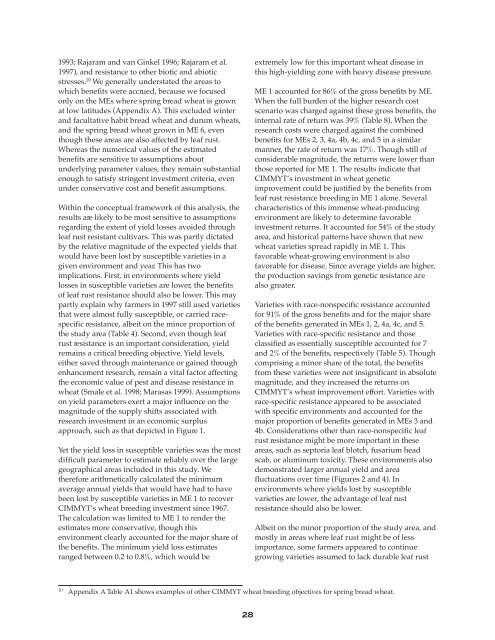The Economic Impact in Developing Countries of ... - AgEcon Search
The Economic Impact in Developing Countries of ... - AgEcon Search
The Economic Impact in Developing Countries of ... - AgEcon Search
- No tags were found...
Create successful ePaper yourself
Turn your PDF publications into a flip-book with our unique Google optimized e-Paper software.
1993; Rajaram and van G<strong>in</strong>kel 1996; Rajaram et al.1997), and resistance to other biotic and abioticstresses. 10 We generally understated the areas towhich benefits were accrued, because we focusedonly on the MEs where spr<strong>in</strong>g bread wheat is grownat low latitudes (Appendix A). This excluded w<strong>in</strong>terand facultative habit bread wheat and durum wheats,and the spr<strong>in</strong>g bread wheat grown <strong>in</strong> ME 6, eventhough these areas are also affected by leaf rust.Whereas the numerical values <strong>of</strong> the estimatedbenefits are sensitive to assumptions aboutunderly<strong>in</strong>g parameter values, they rema<strong>in</strong> substantialenough to satisfy str<strong>in</strong>gent <strong>in</strong>vestment criteria, evenunder conservative cost and benefit assumptions.With<strong>in</strong> the conceptual framework <strong>of</strong> this analysis, theresults are likely to be most sensitive to assumptionsregard<strong>in</strong>g the extent <strong>of</strong> yield losses avoided throughleaf rust resistant cultivars. This was partly dictatedby the relative magnitude <strong>of</strong> the expected yields thatwould have been lost by susceptible varieties <strong>in</strong> agiven environment and year. This has twoimplications. First, <strong>in</strong> environments where yieldlosses <strong>in</strong> susceptible varieties are lower, the benefits<strong>of</strong> leaf rust resistance should also be lower. This maypartly expla<strong>in</strong> why farmers <strong>in</strong> 1997 still used varietiesthat were almost fully susceptible, or carried racespecificresistance, albeit on the m<strong>in</strong>or proportion <strong>of</strong>the study area (Table 4). Second, even though leafrust resistance is an important consideration, yieldrema<strong>in</strong>s a critical breed<strong>in</strong>g objective. Yield levels,either saved through ma<strong>in</strong>tenance or ga<strong>in</strong>ed throughenhancement research, rema<strong>in</strong> a vital factor affect<strong>in</strong>gthe economic value <strong>of</strong> pest and disease resistance <strong>in</strong>wheat (Smale et al. 1998; Marasas 1999). Assumptionson yield parameters exert a major <strong>in</strong>fluence on themagnitude <strong>of</strong> the supply shifts associated withresearch <strong>in</strong>vestment <strong>in</strong> an economic surplusapproach, such as that depicted <strong>in</strong> Figure 1.Yet the yield loss <strong>in</strong> susceptible varieties was the mostdifficult parameter to estimate reliably over the largegeographical areas <strong>in</strong>cluded <strong>in</strong> this study. Wetherefore arithmetically calculated the m<strong>in</strong>imumaverage annual yields that would have had to havebeen lost by susceptible varieties <strong>in</strong> ME 1 to recoverCIMMYT’s wheat breed<strong>in</strong>g <strong>in</strong>vestment s<strong>in</strong>ce 1967.<strong>The</strong> calculation was limited to ME 1 to render theestimates more conservative, though thisenvironment clearly accounted for the major share <strong>of</strong>the benefits. <strong>The</strong> m<strong>in</strong>imum yield loss estimatesranged between 0.2 to 0.8%, which would beextremely low for this important wheat disease <strong>in</strong>this high-yield<strong>in</strong>g zone with heavy disease pressure.ME 1 accounted for 86% <strong>of</strong> the gross benefits by ME.When the full burden <strong>of</strong> the higher research costscenario was charged aga<strong>in</strong>st these gross benefits, the<strong>in</strong>ternal rate <strong>of</strong> return was 39% (Table 8). When theresearch costs were charged aga<strong>in</strong>st the comb<strong>in</strong>edbenefits for MEs 2, 3, 4a, 4b, 4c, and 5 <strong>in</strong> a similarmanner, the rate <strong>of</strong> return was 17%. Though still <strong>of</strong>considerable magnitude, the returns were lower thanthose reported for ME 1. <strong>The</strong> results <strong>in</strong>dicate thatCIMMYT’s <strong>in</strong>vestment <strong>in</strong> wheat geneticimprovement could be justified by the benefits fromleaf rust resistance breed<strong>in</strong>g <strong>in</strong> ME 1 alone. Severalcharacteristics <strong>of</strong> this immense wheat-produc<strong>in</strong>genvironment are likely to determ<strong>in</strong>e favorable<strong>in</strong>vestment returns. It accounted for 54% <strong>of</strong> the studyarea, and historical patterns have shown that newwheat varieties spread rapidly <strong>in</strong> ME 1. Thisfavorable wheat-grow<strong>in</strong>g environment is als<strong>of</strong>avorable for disease. S<strong>in</strong>ce average yields are higher,the production sav<strong>in</strong>gs from genetic resistance arealso greater.Varieties with race-nonspecific resistance accountedfor 91% <strong>of</strong> the gross benefits and for the major share<strong>of</strong> the benefits generated <strong>in</strong> MEs 1, 2, 4a, 4c, and 5.Varieties with race-specific resistance and thoseclassified as essentially susceptible accounted for 7and 2% <strong>of</strong> the benefits, respectively (Table 5). Thoughcompris<strong>in</strong>g a m<strong>in</strong>or share <strong>of</strong> the total, the benefitsfrom these varieties were not <strong>in</strong>significant <strong>in</strong> absolutemagnitude, and they <strong>in</strong>creased the returns onCIMMYT’s wheat improvement effort. Varieties withrace-specific resistance appeared to be associatedwith specific environments and accounted for themajor proportion <strong>of</strong> benefits generated <strong>in</strong> MEs 3 and4b. Considerations other than race-nonspecific leafrust resistance might be more important <strong>in</strong> theseareas, such as septoria leaf blotch, fusarium headscab, or alum<strong>in</strong>um toxicity. <strong>The</strong>se environments alsodemonstrated larger annual yield and areafluctuations over time (Figures 2 and 4). Inenvironments where yields lost by susceptiblevarieties are lower, the advantage <strong>of</strong> leaf rustresistance should also be lower.Albeit on the m<strong>in</strong>or proportion <strong>of</strong> the study area, andmostly <strong>in</strong> areas where leaf rust might be <strong>of</strong> lessimportance, some farmers appeared to cont<strong>in</strong>uegrow<strong>in</strong>g varieties assumed to lack durable leaf rust10Appendix A Table A1 shows examples <strong>of</strong> other CIMMYT wheat breed<strong>in</strong>g objectives for spr<strong>in</strong>g bread wheat.28
















